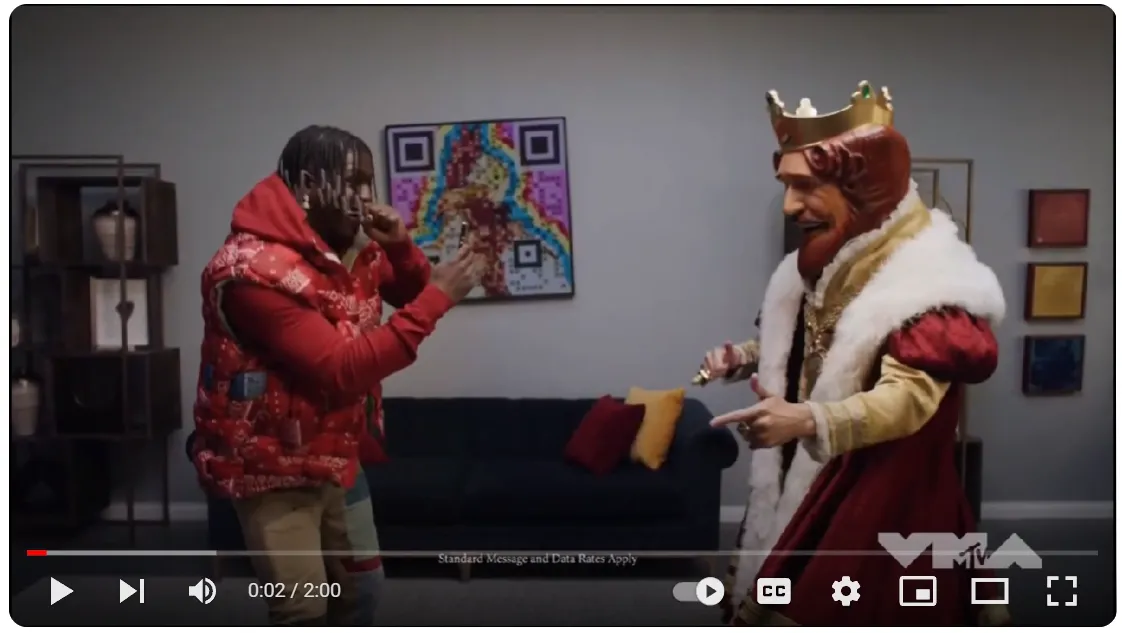Tracking ROI of Traditional Offline Media. How Do You Handle OOH, Print, SMS, Events, Radio, Discount Coupons.
Table Of Contents
- Executive Summary
- Why We Cannot Ignore Traditional Marketing
- Challenge of Tracking ROI for Traditional Media
- Using Vanity URL’s for Tracking Marketing ROI for Offline Lead Acquisition
- Using UTM Parameters to track offline Lead Acquisitions
- Understanding QR Codes for Tracking Marketing ROI for Offline Lead Acquisition
- How to Use Coupon Codes/ PROMO Codes for Tracking Marketing ROI for Offline Lead Acquisition
- Using Redeemable Vouchers for Offline Conversion Tracking
- Cheat Sheet: How to Track Marketing ROI for Offline Lead Acquisition
- Best Practices for Tracking Marketing ROI for Offline Lead Acquisition
- FAQ's
- Read Also
Executive Summary
We have discussed online conversions and offline conversions, both predicated by an online lead acquisition in our blogs previously. But you may ask, that even today, a large number of leads are generated offline- Print, OOH, Events, Seminars, etc. Is there a way in which we could bring track these leads also? The short answer is maybe.
In this article we briefly look at how important Traditional Marketing continues to be, the pressures and challenges faced by Marketing Teams trying to prove Marketing ROI for Traditional Marketing before going on to explore possible solutions (not foolproof) to tracking lead conversion for leads acquired from Print, TV, Radio, Out of Home (OOH), Events, SMS etc.
We conclude with a suggested cheat sheet guide for Marketing Teams trying to track conversion for leads acquired offline.
Why We Cannot Ignore Traditional Marketing:
Traditional Marketing is still going strong. After years of Digital Advertising Spends outstripping Traditional Marketing Media (Television, Print, OOH, Radio, Cinema, etc) spends post-Pandemic, Digital Ad Spend growth is slowing down. If we cut through the clutter, we will see that globally Digital Ad Spends (~58%) are definitely bigger than spend on Traditional Media (for those interested in a deep dive into the trends- Media Outlook May2023 by Dentsu) and will increase in share of wallet, albeit slowly, but it still leaves about 40% of Global Advertising budgets being spent on Television, Print, Radio, OOH, Cinema, etc.
Quiet, a sizable chunk. What is more, different Demographics, consume media differently. As long as Boomers and Gen X continue to matter economically, firms will still have to spend more money on Traditional Media to target them. Readers are referred to our blog- Trends in Global Marketing Spends for insight into media consumption habits for different age cohorts.
And there is the dilemma for Marketing Teams globally.
Challenge of Tracking ROI for Traditional Media:
Attribution, or tracking efficacy of Marketing spends on traditional marketing is notoriously difficult to quantify. If you are broadcasting the channel is literally one way. How then do you measure.
Particularly difficult to track is Brand Communication. You broadcast messages, work on Customer Experience but with so many touchpoints, measuring which message created a subjective difference in the consumer’s perception of the brand is difficult. Over time, Marketing Teams have developed tools like Customer Interviews, Brand Surveys, and even Customer Experience toolkits like the very effective NPS. All in all, while not perfect, these tools suffice.
The bigger problem comes when it comes to measuring efficacy of Lead Generation. The uncertain economic environment over the past few years has put tremendous pressure on C-Suite to cut costs and show revenue generation. As this Harvard Business Review article (How Brand Building and Performance Marketing Can Work Together- May/ June 2023) indicates that this pressure has been increasing over the last 20 years.
Pressure which is transmitted down to the Marketing Team who are under even more scrutiny to justify and show ROI of spending for generating leads and revenue. Imagine the moral dilemma of a Chief Marketing Officer, who knows that his target group needs to be communicated to on Traditional Media yet is not able to attribute revenue to his spending, is increasing. Should he do the right thing and face an uncomfortable Board Review, or, should he go with the flow, and invest in something that is not the best ROI for his firm?
What if there was a way out?
Maybe.
Why maybe? Because to transform information easily from the digital world to an online world in scale, you would need the User to make an interaction somewhere- It maybe a form fill or even a WhatsApp message. If you can do that, then the answer is “Yes”.
Before we go into details of mechanisms, let’s do a quick review of the different scenarios possible in Lead Acquisition and Lead Conversion.
Tracking Online Lead Acquisition- Online Conversion Paths:
Easiest scenario to deal with. Think ecommerce, online white paper downloads, sign-ups. A properly configured analytics backend on your ecommerce store or configuring your Google Analytics and you are set.
Tracking Online Lead Acquisition- Offline Conversion Paths:
Slightly more difficult. Imagine the scenario of a Real Estate firm, Enterprise Software, Heavy Engineering, a professional service (Legal firms, Accounting, Business Consultants), personal services (Hospitality, Spa’s, Healthcare, Automotive, etc). All of them generate leads online but final conversion needs a human intervention and so moves offline. The biggest problem is that you can’t setup tools like Google Analytics, Mix Panel, etc to easily track these conversions. Especially, when you are selling a non-uniform product or service. The better way is to use a CRM like Pronnel to track your whole Lead Funnel. You can refer to the FAQ section at the end of this blog to see references to our documentation on how this can be achieved.
Tracking Offline Lead Acquisition- Online Revenue Conversion Paths:
Slightly more difficult than the previous scenario. Not atypical, but still quite possible. Imagine you are an exhibitor at an event. You don’t have time to speak to everyone passing by. Yet you want to entice people to try your product online for free, or want them to watch your video from YouTube, or, even give them a place to sign up easily for further Sales outreach/ Demo’s. An alternative scenario would be you are running Ads in print or doing a door-to-door Activation campaign to canvas your product. These activities are expensive. How would you be able to justify to your management that the Activation Campaign, or the expense of attending a Trade Show was justified. You can track attribution either through a tool like Google Analytics or using a CRM.
Tracking Offline Lead Acquisition- Offline Revenue Conversion Paths:
The trickiest attribution scenario- Enough to make most Marketing Teams throw up their hands in despair. The client most probably saw your message on TV, a Billboard, received a SMS or a Print Campaign, and then either walked into a store, called on the phone to move ahead in the Sales Cycle. The tracking can be if there is only contact at payment time- directly in ERP, or, if there is a sales cycle, through an intermediate CRM/ Lead Management System like Pronnel, which tracks not only origin and final conversion amounts but also, the Sales Cycle steps in between.
Of these four scenarios, finding solutions to the last two, using QR Codes, Redeemable Vouchers, Coupon/ PROMO Codes, dedicated URL’s and UTM Codes, is the focus of this blog.
Using Vanity URL’s for Tracking Marketing ROI for Offline Lead Acquisition:
Using a Vanity URL (creating a unique URL that is branded for marketing purposes) that redirects to a dedicated landing page, or a microsite is a great way to get consumers to reach out across to you from an offline campaign, and, yet provide powerful tracking in place.
Ok, that’s quite a mouthful. Let’s see how this works.
Vanity URL’s as the definition suggests, are short, relevant, catchy and easy to remember. If consumers remember the URL, then it is likely that they will enter it and reach out. Studies have shown proper use of vanity URL’s can increase engagement by as much as 35%. Suppose, Pronnel, tomorrow decides to exhibit at a Trade Show to promote it’s WhatsApp Based CRM and wants consumers to guide consumers to read the blog and sign up. The URL for the blog is https://pronnel.com/blogs/Finding-the-perfect-WhatsApp-Based-CRM-to-Serve-Your-Customer.html
No way, a consumer would remember, or even care to remember this long URL. What happens if instead we handed out brochures/ flyers with a Vanity URL like below, which would be easier for people to remember and make them curious to try it out.
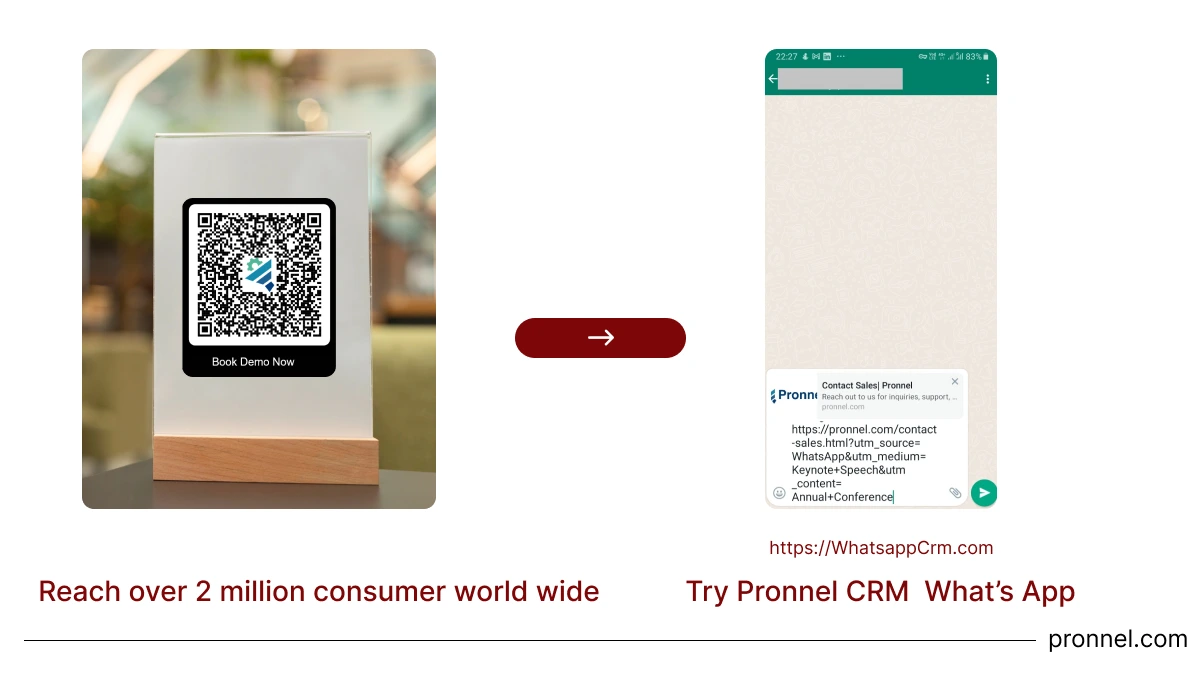
Whenever someone enters this link on their browser, they would get redirected to the original destination page. If a vanity link is snazzy enough, you can even use them in media like Radio or even TV. Audiences will remember.
Now, if you are using a dedicated landing page or custom microsite for this activity, then it is easy to attribute the effect to this singular campaign. However, it can quickly become a problem if multiple campaigns/ Ads end up using the same lading page. Or, for that matter you are taking them to an already in use, non-unique page on your website. Then Tracking can go for a toss, and you will have a host of Direct Traffic swamping your data. Use of UTM’s can provide a way out of this, which we will see briefly in the next section. For a more detailed discussion on UTM’s you can refer our blog- Tracking Last Mile Conversions with UTMs. Before we move on, there’s another reason to consider before deciding on using vanity URL’s- The time and expense needed to create unique URL’s and landing pages.
Using UTM Parameters to track offline Lead Acquisitions
UTM’s, provide a powerful way of capturing tracking data of the Source, Medium and Campaign that is bringing a visitor to your page or App. While UTMs have their own drawbacks, they do not infringe on privacy and can give you intelligence on where your visitors came from. Another advantage is that UTM tracking is readily available on all common analytics platforms like GA4, Microsoft Clarity, MixPanel, Kissmetrics, Adobe Analytics, Amplitude et al.
So, were we to create a link encouraging registration for demo’s that would solely, be put on a hoarding in Dubai’s Sheikh Zayed Road, we would actually have done the following:
Original URL:
UTM appended URL for putting on Hoarding:
Every time we get a Demo request which comes with the UTM Parameters, you will know that your million-dollar investment in a billboard on Dubai’s main avenue is paying you back. If you are interested in knowing how a CRM like Pronnel can capture UTM’s you can go through the short video below.

Now, wait minute. We solved the tracking problem, but putting a 124-character link on any medium, leave alone a billboard, is a sure-fire way of ensuring that no one will care about it?
What should we do? One way is obviously, using the UTM appended link as the starting point of creating a Vanity URL. But then again, there’s an even more elegant solution (at least works very well on Print, TV, and quite a few OOH formats). Let’s look at QR Codes to see how they can help.
Understanding QR Codes for Tracking Marketing ROI for Offline Lead Acquisition
The drawback of using links, in any media format, no one remembers them. How many memorable vanity links will a Marketing Team create for a set of brands? Enter the QR Code. Launched in 1994 by DENSO Corporation in Japan who were trying to experiment with encoding more information in bar codes. QR (Quick Read) Codes, really took off around 2002 in Japan with the proliferation of mobile phones with a QR Code Reader. With the rise of smart phones today almost all phone families (Android, iOS, Harmony, Windows Phone, BharOS) have QR reading features incorporated with the camera.
Now, imagine we want to replace the 124-character UTM appended link in the above example (https://pronnel.com/contact-sales.html?utm_source=ooh&utm_medium=billboard-dubai-sheikh-zayed&utm_campaign=whatsapp-crm-demo). All we must do is enter the long URL in a QR Code generator, generate a QR Code and place it on the billboard.
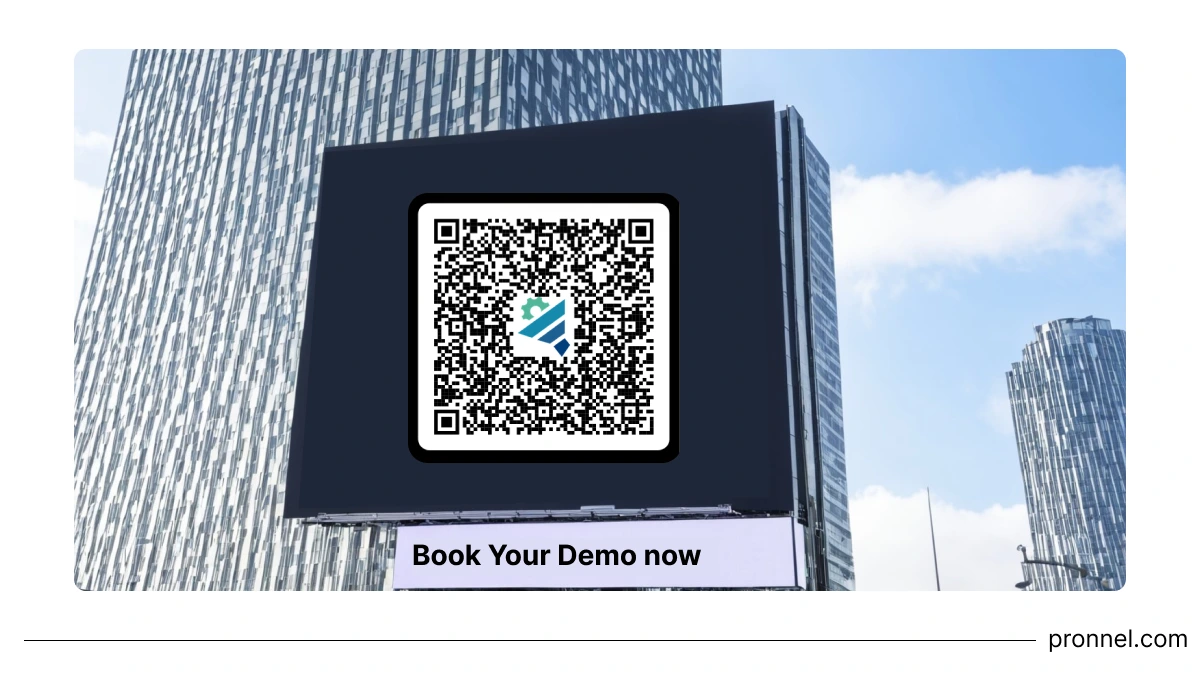
Clever Marketers have used QR codes even in media like TV very effectively. Burger King ran a series of TV Commercials during the MTV VMA’s in 2020 incorporating a QR Code (which effectively hid a download link to the Burger King App).
Other advantages of using QR codes are that instead of a simple form fill a QR Code maybe used to drive other CTA’s like:
Send WhatsApp or Telegram using a QR Code
Will open the App on the Users phone to the correct number. Can also incorporate a pre-coded message. Refer FAQ section for How To- Offline Acquisition Tracking with QR Codes for a WhatsApp CTA.
Send Email using a QR Code
Can incorporate a pre-coded Subject and Mail Body
Call a Phone using a QR Code
When scanned by a smartphone a QR Code will open the calling panel.
Send an SMS using a QR Code
Can incorporate a short pre-coded text
Send a payment link with for a Product using a QR Code
Can incorporate SKU Code, Product Name, Quantity, Price, Currency, Shipping and Taxes
Do Event Registrations using a QR Code
Communicate Event location, timing, etc.
App Download through QR Code
Opens up Play Store or Apple Store depending on the OS of the phone.
Share a YouTube link using a QR Code
Can incorporate the UTM for tracking.
Share Social Profiles like Facebook, Instagram, LinkedIn, TikTok, Twitter, Snapchat using a QR Code
Share a Google Map location using a QR Code
When scanned by a smartphone, the QR code will open your navigation.
Open a PDF/ PPTX/ Text File using a QR Code
When scanned by a smartphone the document downloads to the persons phone and opens.
The only caveat for using QR Codes in OOH advertising or on moving visuals like TV or rolling video Ads is that sometimes the contrast, ambient light conditions and time needed to focus camera and read them may be a constraint.
How to Use Coupon Codes/ PROMO Codes for Tracking Marketing ROI for Offline Lead Acquisition.
PROMO Codes/ Promotional Codes/ Coupon Codes have been around for ages. Initially associated with printed coupons distributed through newspapers and other Print media to entice consumers with a discount or offer, they came back into vogue with the rise of the internet in the early 2000’s.
By giving consumers a short alphanumeric code that they could redeem at the Point of Sale (POS) for a short discount, Marketing Teams found a way to track the efficacy of their communications. For an offline transaction, the salesperson could enter this data directly into the ERP or CRM at time of purchase, associating the sale directly to the offer. If, for example, a grocery store ran a promotion-“EGGS50%”, and a consumer came in and purchased not only the eggs at 50% off, but also bread, milk, cereal, orange juice, then the Marketing Team could very well claim, that their offer, not only moved eggs off the shelf but also sold the other items in the basket. With this promotion, they were able to claim a larger share of the consumers wallet, which could easily have gone to competition.
As a rule of thumb, a PROMO Code needs to be short and easily memoizable. You could use Promo Codes not only on offline Print Media, OOH, Radio, TV, Cinema Advertising but also online on your blogs/ website or even assign specific Promo Codes to Influencers. Whether redemption is online or offline, you can use your CRM to track usage. Those interested in examples of CRM usage to track can refer our blog on “Influencer Marketing | Tracking ROI”.
PROMO codes are generally very useful for instant/ impulsive purchases like groceries, apparel, auto servicing etc. They are also useful for attracting consumers to try out new products and services. Spa’s, aesthetic clinics, personal development courses, new SaaS products, etc are all examples of categories using them successfully.
Using Redeemable Vouchers for Offline Conversion Tracking.
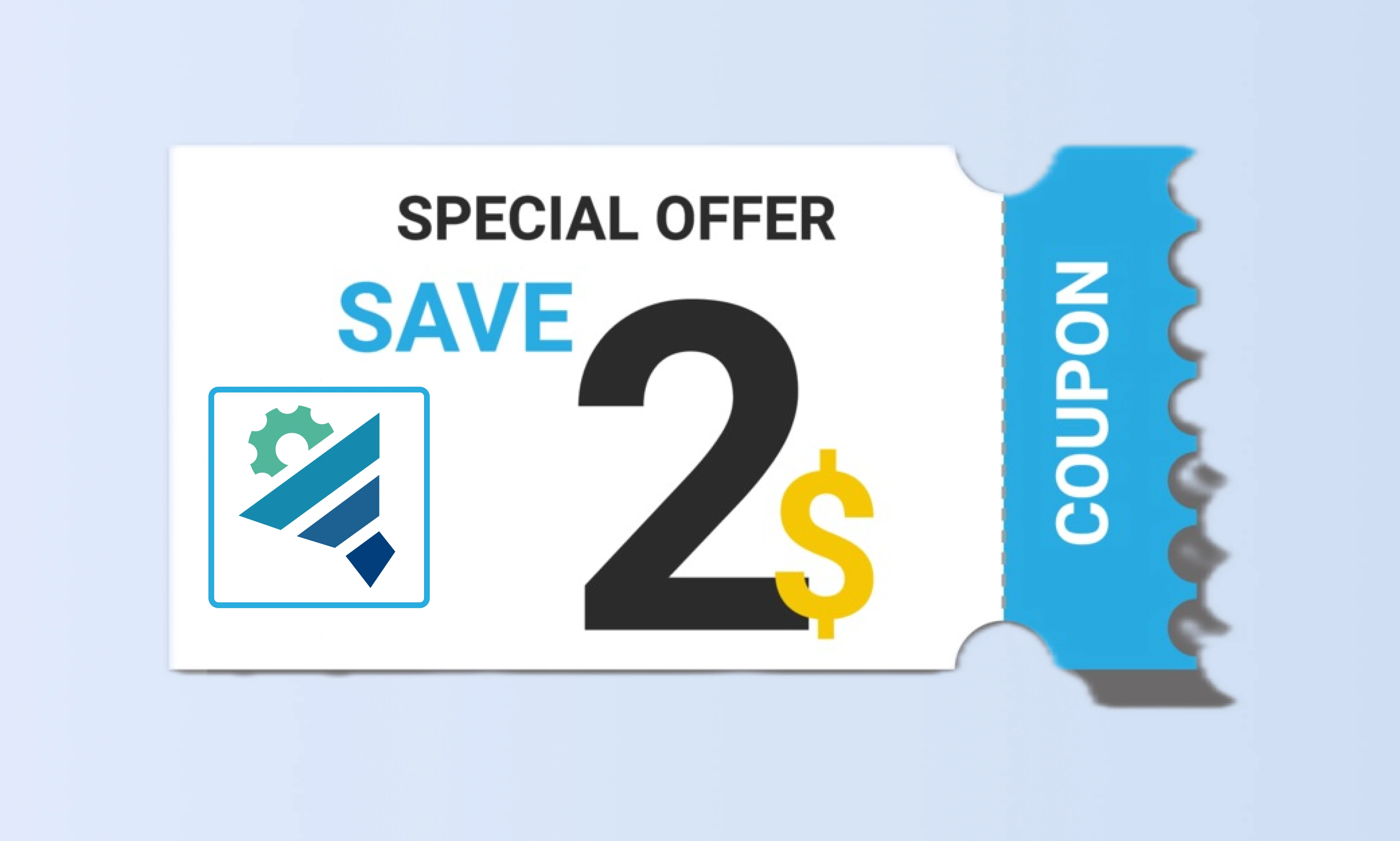
Tracking leads generated from online Marketing communication that do not go through any intermediate online interaction and are redeemed only at POS is the trickiest path. One-way firms have been tackling this is through using Redeemable vouchers mostly as newspaper inserts, which shoppers present physically when making a purchase.
Cheat Sheet: How to Track Marketing ROI for Offline Lead Acquisition.
Once you determine your Marketing Mix, and your final objectives, you need to determine what CTA’s are your target group most comfortable to work on. Based on that you can use the Cheat Sheet given below to determine what device/ tracking method you should use to capture your consumer journeys. You may choose one, or a combination of tools like a Vanity Link, QR Code, Dedicated Number/ Call Tracking, PROMO Code, Redemption Voucher to launch your campaign. One final check before embarking on the campaign- Make sure your ERP/ Google Analytics/ CRM is setup and can handle the information.
Best Practices for Tracking Marketing ROI for Offline Lead Acquisition.
Does It Need Fixing?
Just because there are tools available to track, does not mean that we must track every activity. While evaluating whether you want to granularly track a specific activity weigh the scope of impact and insights vs the efforts needed to roll it out, check for accuracy and whether or not it will cause an overload of unnecessary information in your Customer Data Platform (CDP).
Implement An Appropriate Tracking Mechanism
Using the cheat sheet above determine a course of action and roll it out.
Test It Out Before Rolling It Out
Make sure you run enough tests covering different scenario’s before rolling it out to the world. Your CDP (Customer Data Platform) needs to be protected against data poisoning.
Experiment, Evaluate, Iterate.
It is likely that despite intensive testing, your initial results will throw up surprises. You need to forewarn your teams about this with the caveat that any new tracking program needs at least a quarter of data before you can draw solid conclusions. Use the initial time to experiment and iterate your models.
FAQ’s
Q1: How do you track Marketing ROI for Online Lead Acquisition and Offline Revenue Conversion?
Ideally you need a CRM/ Lead Management System that will aggregate all leads generated online and leads generated offline into a single window where they can be assigned to team members, followed up, reviewed and outcomes recorded so that you have a granular view of which campaign gave you how much return.
Our entire blog series on Performance Marketing discusses the different online sources and how to aggregate leads in one place for conversion tracking and ROI Measurement.
Organic Lead Tracking
Search Engine Marketing- Paid Ads on Google, Bing and Yahoo
Tracking Leads from META properties- Facebook and Instagram
Tracking Leads from LinkedIn
Tracking Leads from TikTok
Tracking Leads from Snapchat and Twitter
Tracking Leads from Influencers
Q2: How Do You Track Offline Lead Acquisition QR Codes opening to a Webpage?
Let’s use a standard QR generator like https://qr.io/. Using the above example let’s set up a QR code for a billboard which carries an offer for “End Of Season Sale” which is featured on a billboard on Times Square. The sample URL can be- https://pronnel.com/contact-sales.html?utm_source=OOH&utm_medium=Paid&utm_campaign=End+Of+Season+Sale&utm_content=Times+Square%2C+New+York
The next thing to do would be to convert this into a QR code by plonking this URL into a QR Code generator.
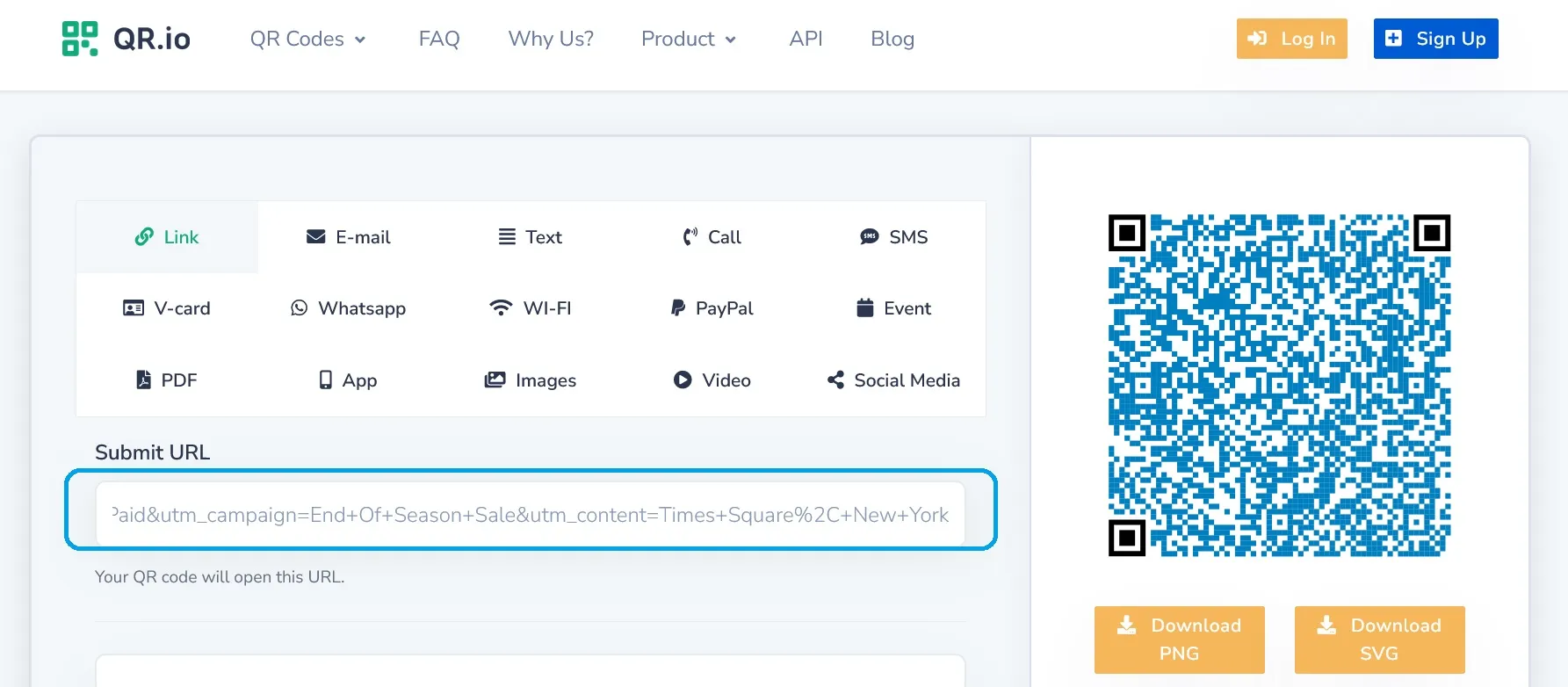
Q3: How Do You Track- Offline Lead Acquisition with QR Codes with a WhatsApp CTA?
With the rise of WhatsApp, consumers world over prefers reaching out through it. Rather than asking people to memorize numbers, why not give them a QR Code that they can scan and send an instantaneous message which can be captured in your CRM and tracked (Pronnel already captures leads from WhatsApp. To know more about how to use Pronnel’s WhatsApp CRM read our earlier blog-WhatsApp-Based CRM | Blogs (pronnel.com)
Same steps as before to generate a new URL with UTM Codes embedded- https://pronnel.com/contact-sales.html?utm_source=WhatsApp&utm_medium=Keynote+Speech&utm_content=Annual+Conference
Generate a QR code which when scanned will open up WhatsApp on an users phone to the contact number provided and show a message ready to be sent.
Whenever the user scans the QR Code, WhatsApp will open to a screen like this. As long as the user hits send, the data will get captured.
Pro-Tip Many users may feel uncomfortable hitting send on a message which has a large URL string attached to it. We recommend instead of using all the parameters to either use a URL Shortener or utm_id.
Q4: Are QR Codes Safe? How can they get hacked?
QR Codes are safe for the most part. However, because QR codes are often found in public places, hackers can stick their own QR stickers over legitimate ones in a way which can fool anyone not looking carefully. They can then hijack the traffic from users scanning these codes to infect their phones with malicious software, steal money or even spoof them into visiting other sites. You can read more in this article – “QR Codes and Hackers | How QR Codes Get Hacked” on how you can keep yourself safe.
Read Also
This blog is the fifth in the series on Lead Management. Dive deep and check out our other blogs:
- Mastering Marketing ROI: Tracking Success (pronnel.com): What Is Marketing ROI (ROMI)? Why is it important? How do you build a system to track marketing ROI?
- Practical Steps to Track Marketing ROI (pronnel.com):How to Track Your Marketing Performance- From Zero to ROAS to ROMI with downloadable templates.
- Trends in Global Marketing Spends:Globally consumer media consumption habits are changing. You need to be where your consumers are. The toss-up between Traditional Media and the Digital World is not so clear cut. Depending on whether you are targeting the Boomers, Gen X, Millenials or Gen Z, you need to plan your media mix. We also briefly discuss how changing Privacy regulation is impacting advertising.
- Google Is Not the Only Game In Town:Search has become synonymous with Google. But based on geography, User preferences and niche, there are other Search Engines to keep in Mind. Understand the difference between Organic and Paid Search results.
Subscribe To Our Blogs
Get the latest blog notification into your email.
